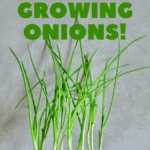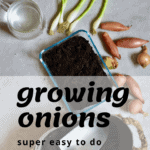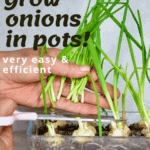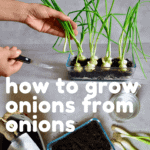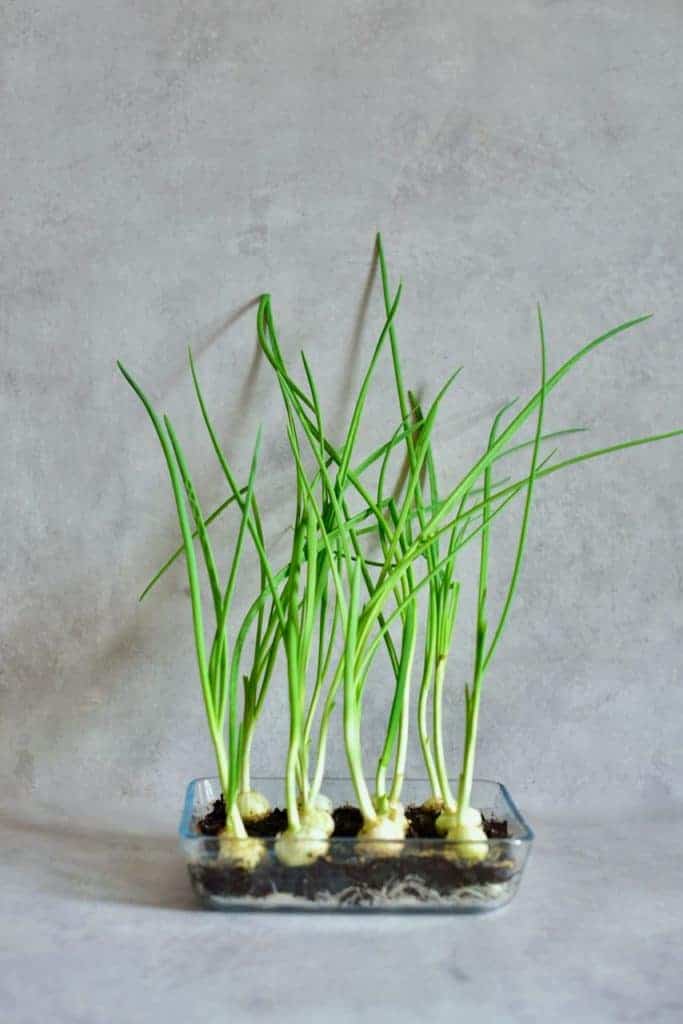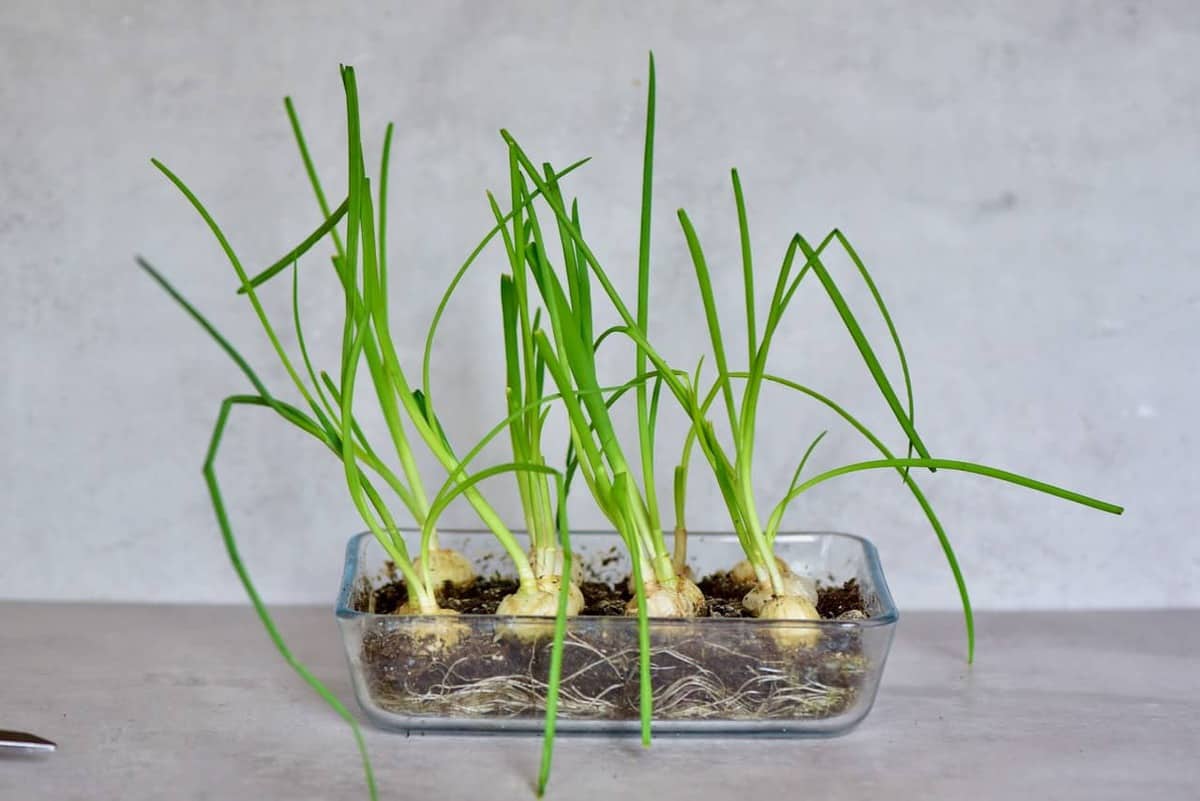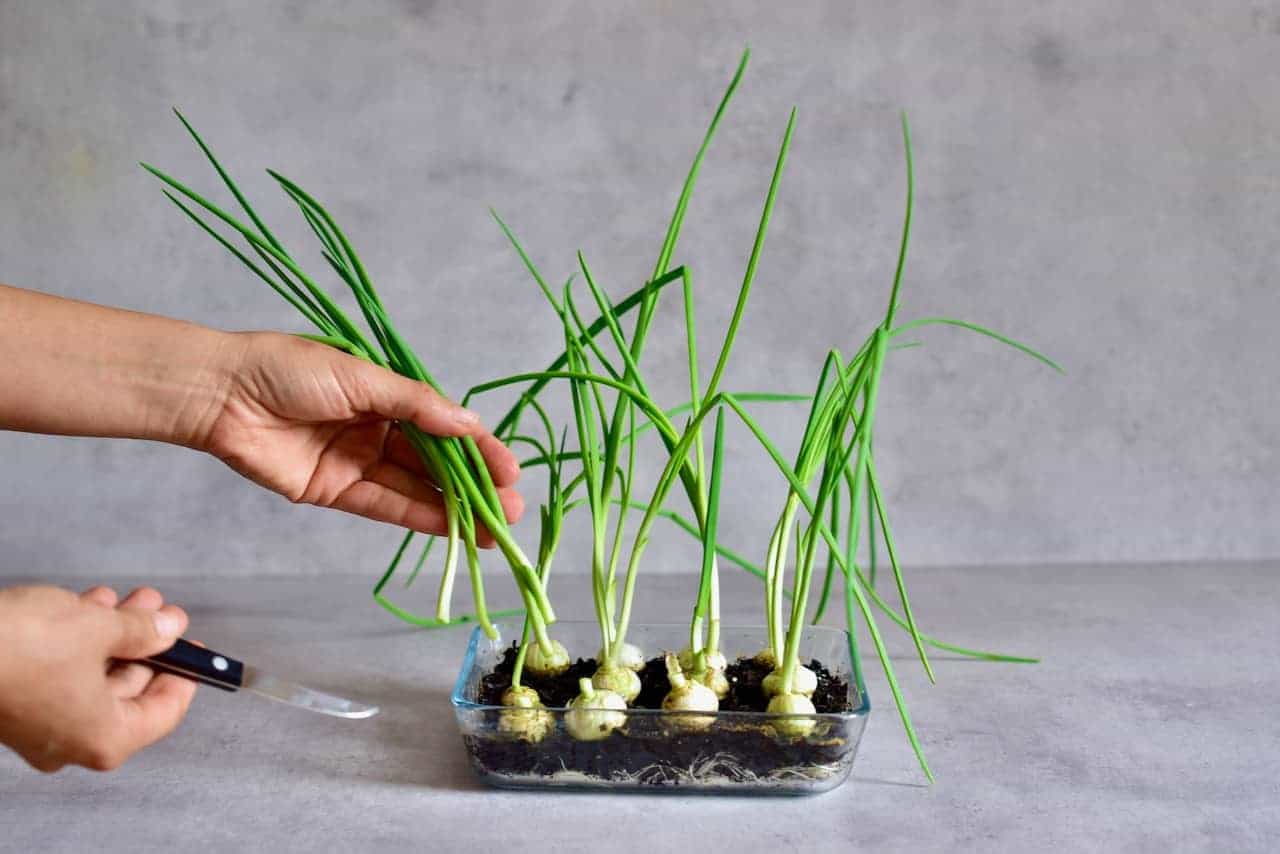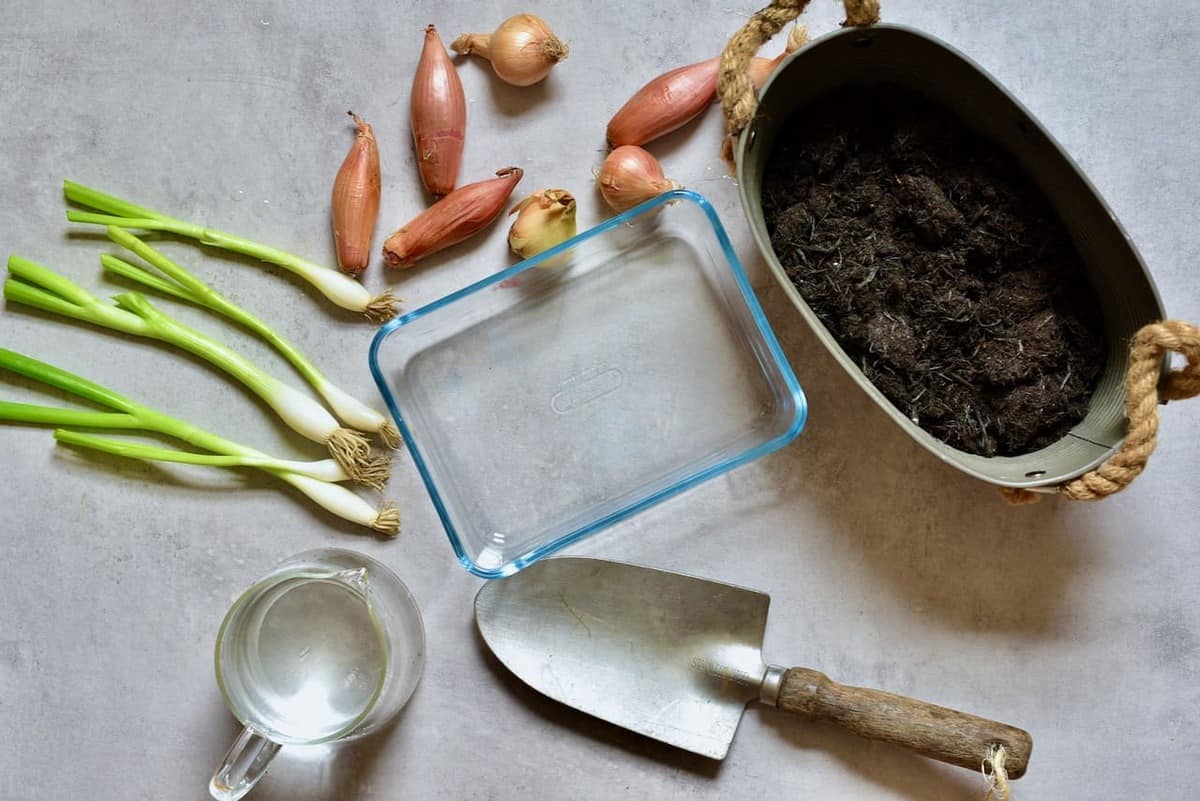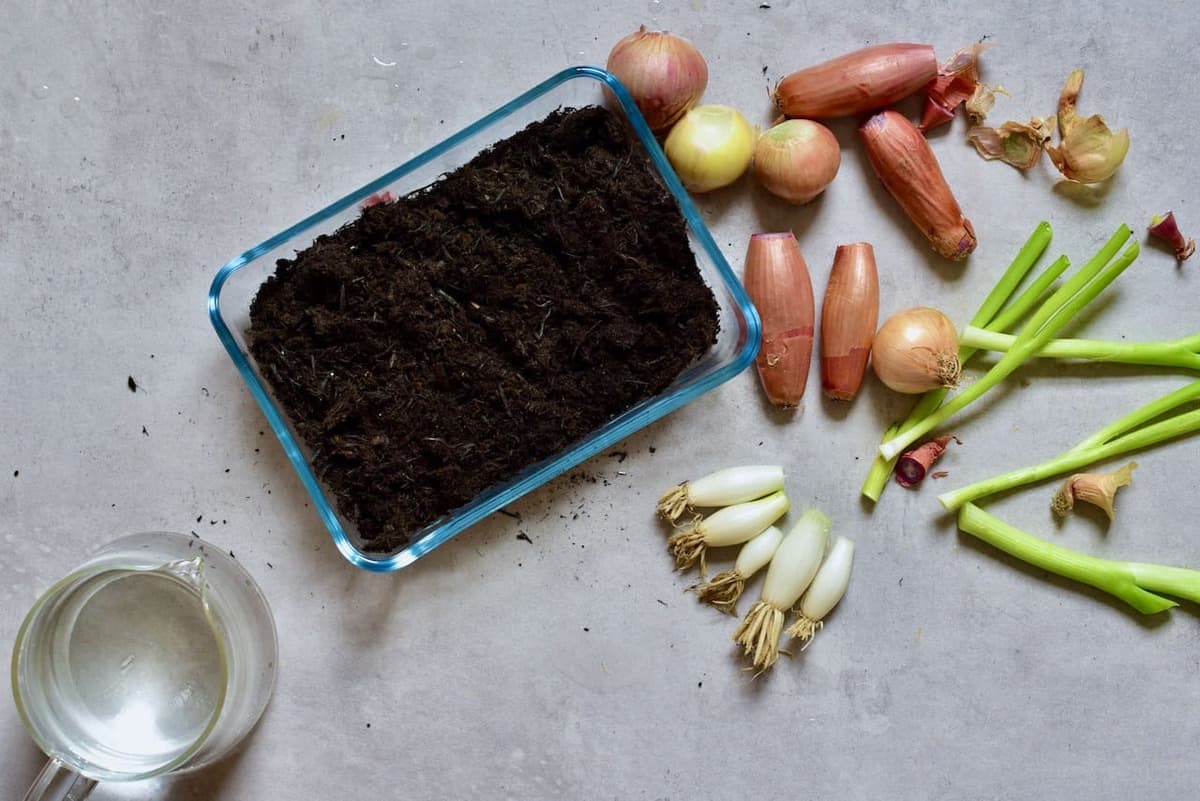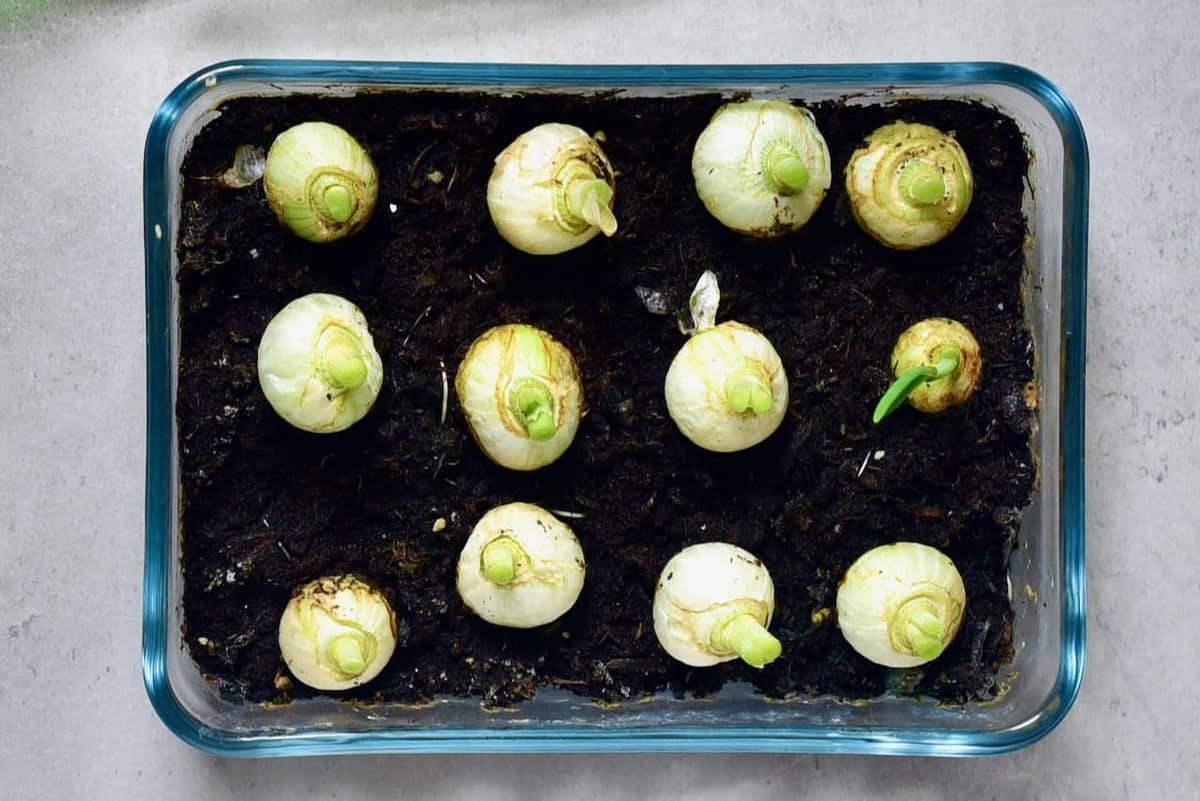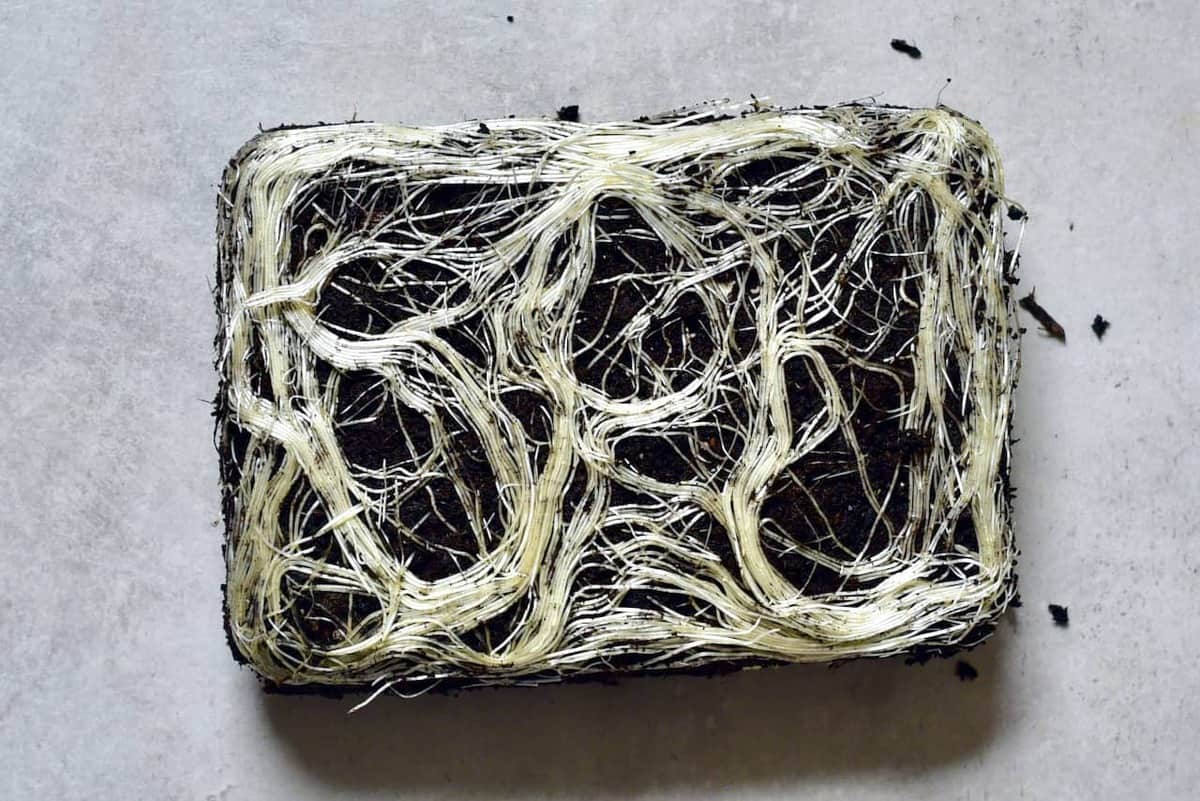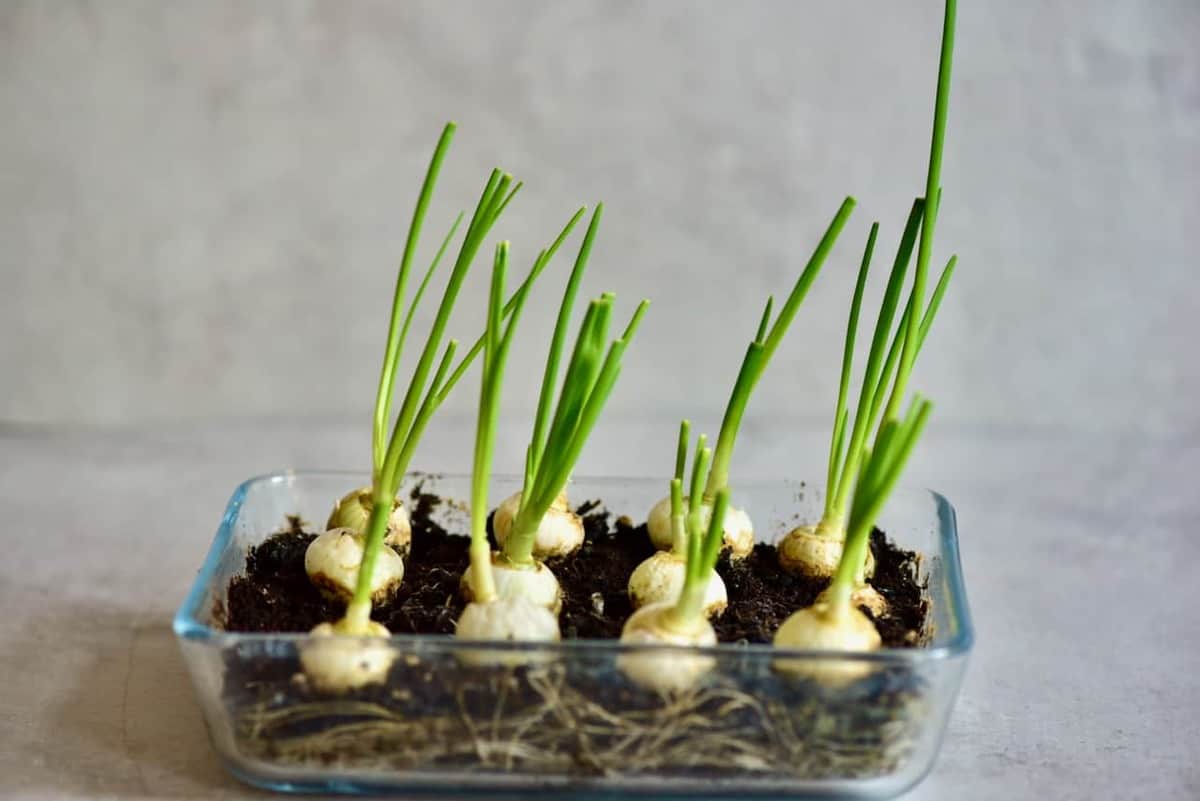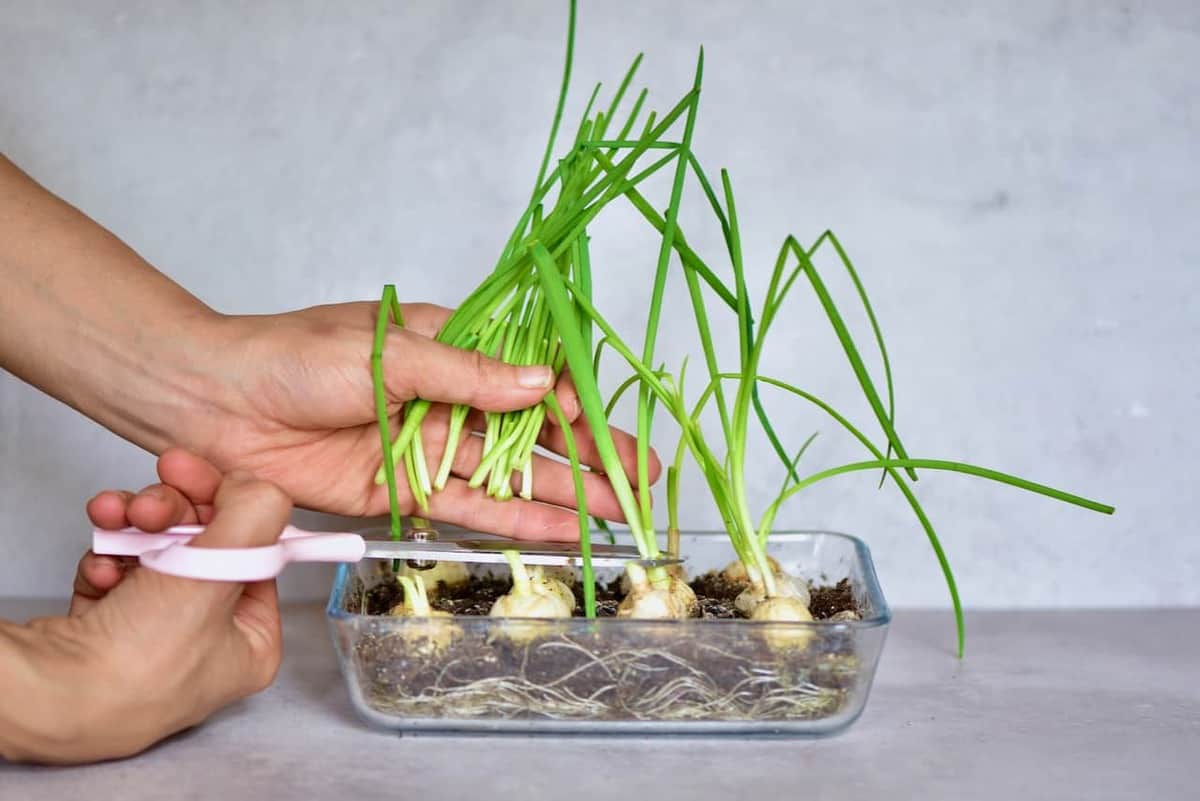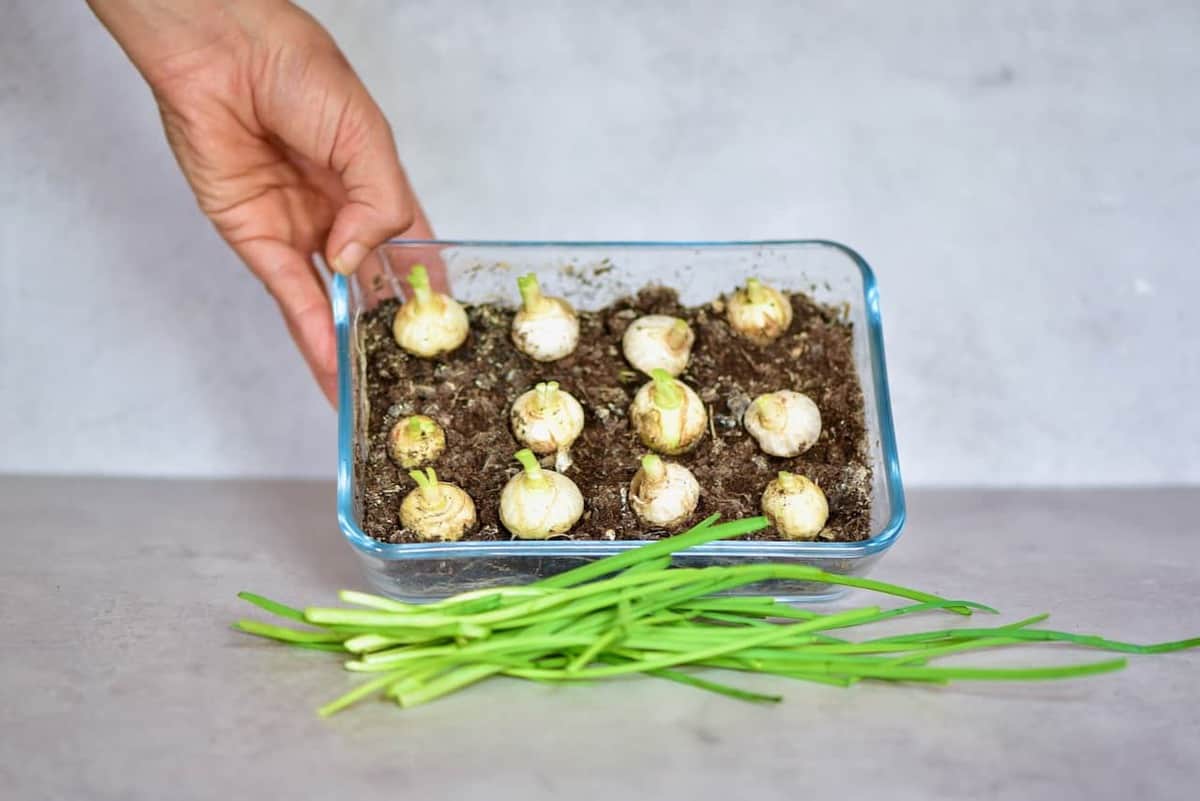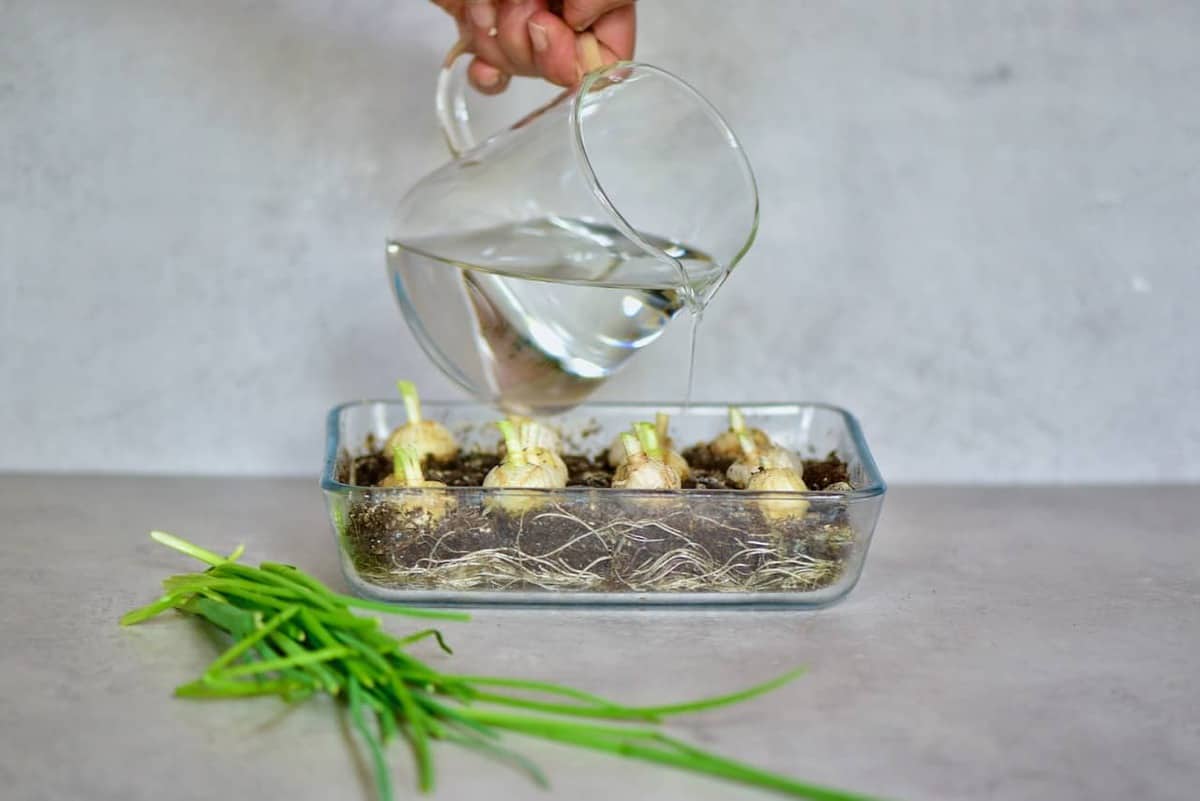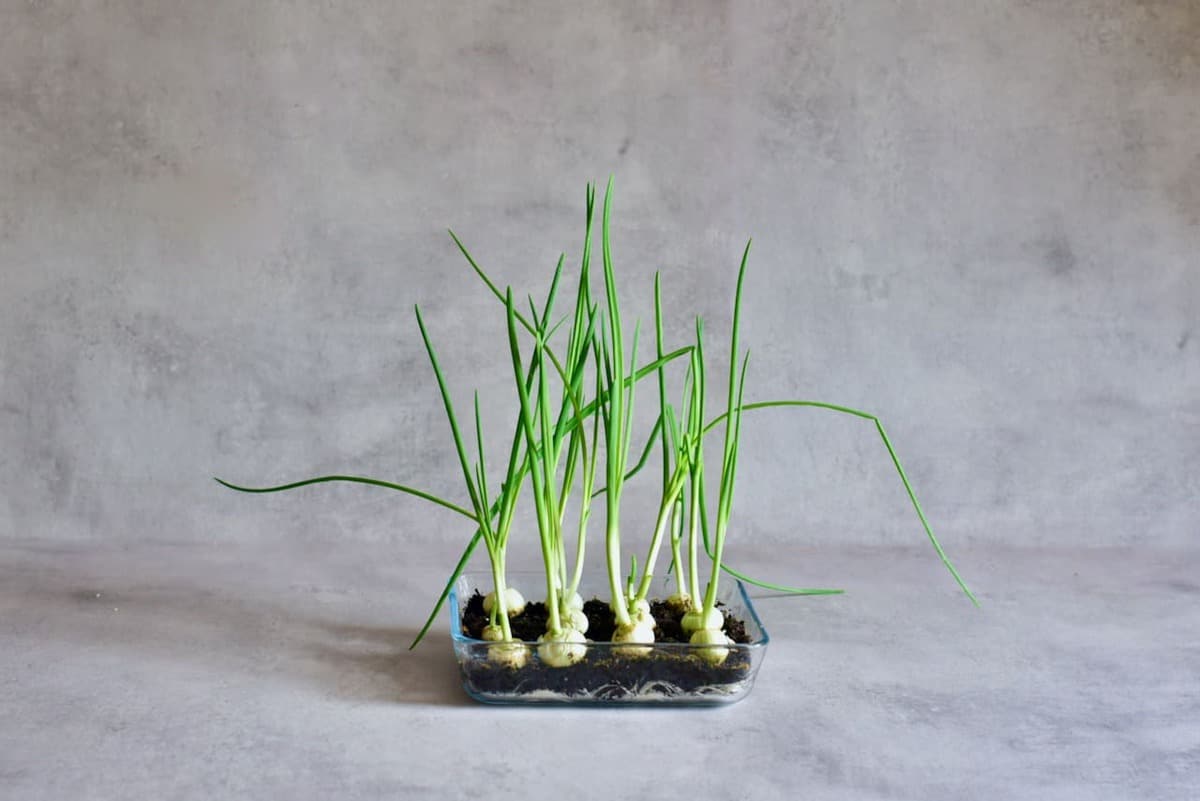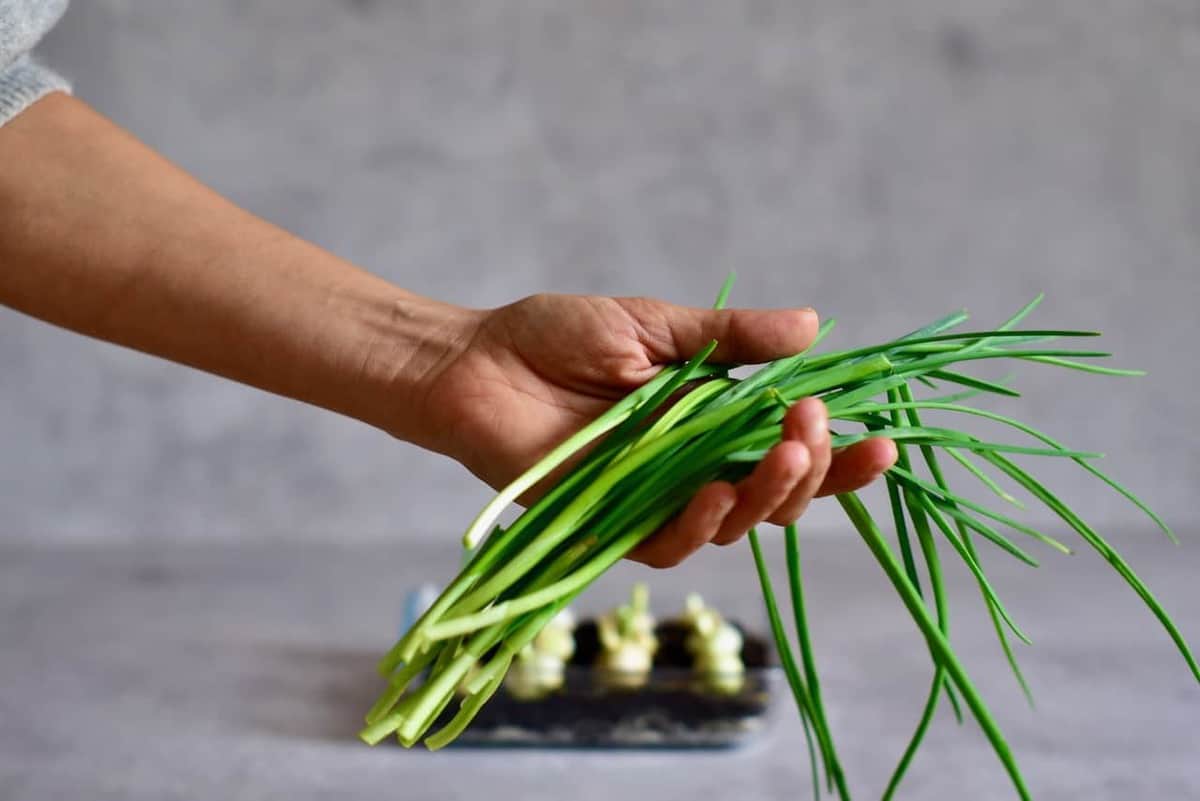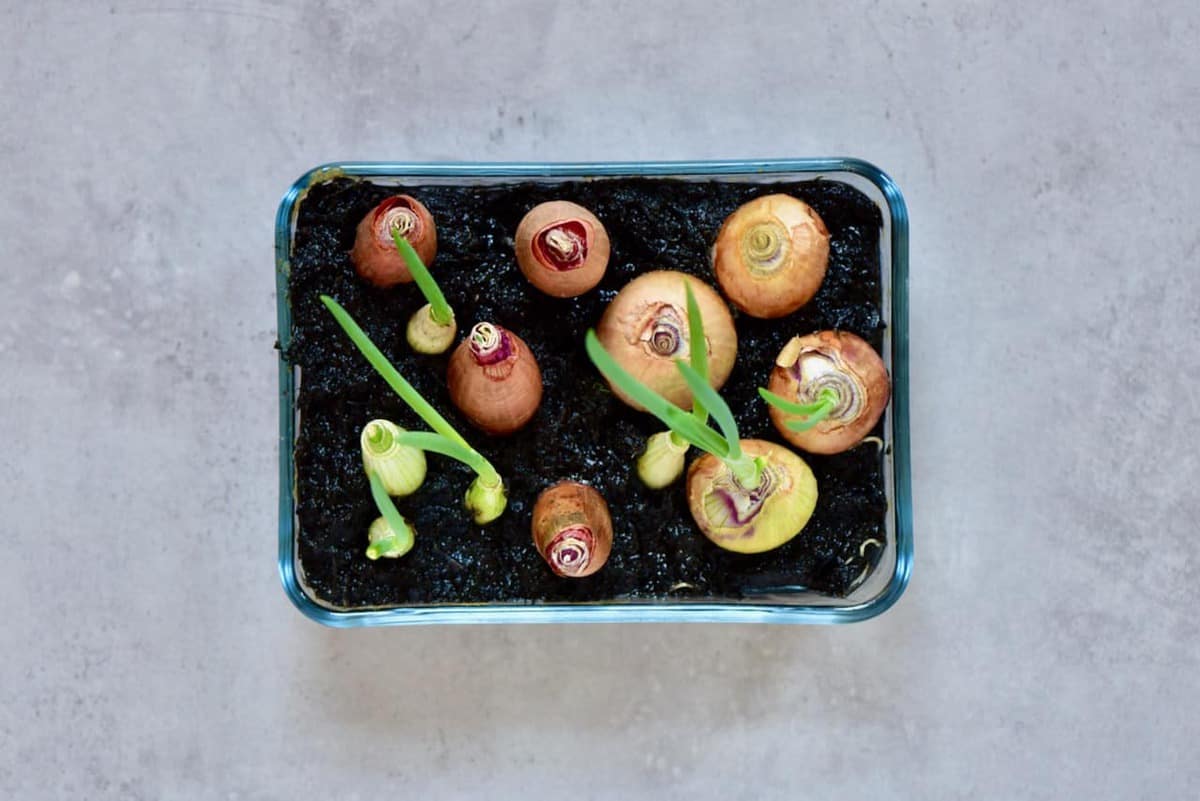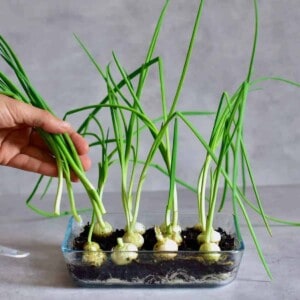I struggled with what to title this blog post because it’s not about growing spring onions at home from scratch, but rather it’s about how to regrow onions from your food scraps. This can be done with spring onions as well as a variety of other onion variations.
In fact, there is a whole collection of vegetables that you’re able to ‘regrow’ at home, fairly mess-free. This helps to reduce food waste, plus, it’s also a great way to save money on your weekly food shop. The best thing is you can do this indoors in a tiny apartment, in a city. And believe me, I’m saying that from experience. So it’s something everyone can do, even without any garden so to speak. I’ve made it a mission to spend more time in 2020, focusing on more sustainable practices as well as growing and regrowing my own produce and home. These spring onions are a great way to begin my ‘year of growing’ though, and good encouragement to add them to my diet more. I’ve mentioned this a few times in other blog posts, but I’ve been on the waiting list for a community garden plot for what feels like forever. I’d been putting off all my ‘gardening’ for way too long, waiting for the day I’d be told a space was mine. Finally, I’ve come to realise that I may never get that call and there are things I can do even from my apartment, right now.
First, What are Spring Onions and What Are Their Health Benefits:
You know how much I love to learn all about the health benefits of what I’m ingesting. Well, towards the end of last year, I came across an article about spring onion, and it made me realise how much I underappreciate this ingredient. So much so, that I thought buying some and re-growing them at home would be a great way to encourage me to use them more. I won’t go too much into the technical side of things within this blog post as I’m no gardening expert. In fact, I was surprised at just how many names there are for spring onions across the globe: green onion, baby onion, salad onion, syboe. The more I read, the more confused I got and started to question everything I’ve ever known about onions. If you want to learn more about the exact differences between green onions, chives and spring onions, then this is a good source, I think. Although I’ve seen images showing ‘spring onions’ with and without the large, rounded bulb. Within this post, I bought and used spring onions with a small, slightly rounded bulb at the bottom that grew into more substantial, round bulbs. These onions are basically just ‘young’ onions that were harvested before becoming the larger variety with a ‘skin’.
What do Spring Onions Taste Like?
In terms of taste, they have a similar flavour profile to onions. However, spring onions are much milder in flavour. Plus, the shoots and bulb ( the greens vs white bits) also differ in flavour, with the white bulb part being a lot stronger in flavour than the greens. One of the reasons I’ve come to love spring onions is that they are almost like two ingredients in one. You can use the shoots for one purpose and the bulb for something else entirely when you’re done regrowing the shoots.
The health Benefits of Spring Onions:
Spring Onions are a type of ‘Allium’ plant ( this includes leeks, garlic, chives, shallots etc.), which all have a variety of wonderful health benefits.
For example, Spring onions are an excellent source of Vitamin C as well as Vit B and Potassium. They are particularly nutrient-dense too, as they are low-calorie and yet full of vitamins and minerals. They are also a good source of antioxidants with lots of anti-inflammatory properties. These help to reduce cholesterol levels, regulate blood pressure, and lower triglyceride levels. Allium Vegetables, in general, are known to have anti-cancerous properties. This is particularly concerning certain cancers such as stomach cancer and colorectal. There have also been studies showing how the compound ‘onionin’ in allium vegetables can slow down tumour development and spread of lung and ovarian cancer. All Alliums have antibacterial and antifungal qualities, which has obvious positive benefits on our bodies ( and great for cold and flu sufferers!). They are also an excellent ingredient to include for a gut-healthy diet. Not only are they a great source of dietary fibre, but they are also full of prebiotics, which works wonders on our gut biome and healthy gut bacteria. Onions can be used to relieve sinus issues, including asthma and bronchitis and have been used in Chinese medicine for these purposed for centuries. Their high Sulphur compounds work wonders for our skin, liver, immune system and help to purify our blood.
How To Grow Spring Onions At Home:
Luckily, the process of using onion scraps for regrowth is incredibly easy. There are two super simple methods that I’ll be mentioning here so you can take your pick.
All you need to regrow these onions are:
A container: Spring onions have a very shallow root system and don’t need a lot of space, so can be grown in fairly small containers. Potting Soil ( which is fairly inexpensive and can be used for a variety of home-growing purposes). Alternatively, the second method uses just water. Spring Onion scraps ( just the bulbs and roots are needed)
Note* this can also be done with other onion variations. I’ll mention a few below. However, my main focus here is on spring onions. To re-grow spring onions, first, you’ll need some existing ones that you’ve bought. If you’re wondering how to cut spring onions, then I like to go with the 1 inch rule. Simply cut above the white area of the onion, which is around 1 inch from the bulb/roots.
How to Grow Spring Onions with Soil:
Fill your container of choice with potting soil. Ideally, you’d want a container with holes so that that excess water can escape. However, if you’re using any other type of container, then make sure now to overwater them ( a sprits bottle could be good!) or get rid of the excess water by draining it, if necessary. The soil needs to be about an inch deep in your container.
Plant the white bulbs halfway in the soil and evenly spaced in your container. Water regularly but make sure not to overwater as this can ruin the growth and cause mould issues. The onions will start growing within a few days.
Enjoy fresh onions as soon as they’ve grown a few inches tall – cut above the white part. Note* I read a somewhere about picking the outer leaves of the spring onion only and that way new ones will continue to grow in the centre, thickening up the base, and your plant will last even longer. Spring onions will also grow edible flowers. However, I’ve never left mine long enough to find out if this is the case with onion regrowth. If I try it anytime soon, I’ll update my blog post ( let me know in the comments if you have n answer).
If using the entire harvest of leaves, then keep watering and wait for a second harvest.
Harvest 2-3 times. Then you can use the bulbs as well, discard the roots and start again with new ready-grown spring onions. Note* Alternatively, if you snip small sections of the plant off ( and never more than half), then the onion should have enough plant left to regrow repeatedly and will last a lot longer. Note: You can grow different types of onions (not just spring ones), but they grow at varying speeds. Just plant the onion bulbs halfway in the soil as you did with the spring onions and water often.
Method 2: How to Regrow Spring Onions with Just Water:
This is a method that can get spring onion regrowth quickly. The water will help the roots grow fast, because of all the moisture. However, the onion won’t be getting any new nutrients like soil planted version would and so will thin out quicker and won’t last as long, overall. Cut the onions 1 inch above the root and place in a tall glass with a few inches of water. Change the water daily and keep the glass in a well-lit area. As I said above, the leaves will grow quickly and can be snipped off as needed. Just like with the soil-grown onions, cutting individual outer leaves near to where it meets the bulb is better for the plant that snipping right from the top. This way new leaves will grow in the centre and It’s also better for reducing germs/pests etc. from entering the plant. And it really is as simple as that. Depending on how long you’re wanting to keep the plant going then you can decide which method you prefer.
The How-To for Growing Onions:
Well, this really depends on exactly what onions you’re growing. Storing onions with skins is massively different to storing spring onions. Spring onions don’t last very long in the fridge at all, for instance. If removing from the plant to use at a later time then I suggest wrapping it in some beeswax wrap ( or clingfilm, if that’s all you have) and keep them stored in your fridge crisper drawer for up to a week, maximum. I prefer to just use the spring onion directly from the plant, as and when needed.
How to Use Spring Onions:
Spring onions are a delicious way to boost a meal. As I mentioned above, I love the fact that the shoots ( leaves) and bulb have different flavour profiles and can be used for different uses. The bulb is the actual ‘onion’ and is much stronger in flavour. This can be used anywhere you would use any other onion. The green tops (leaves) are milder in taste and can be used as a garnish, within stir fries, to flavour broths and pasta, within sauces, in salads, omelettes etc. You can even sprinkle them over pizza if you want- the sky is the limit. … If you’d like me to do more DIY’s for regrowing food from vegetable scraps or general growing of produce, let me know in the comments. Also, feel free to tag me in any of your recreations @AlphaFoodie.
